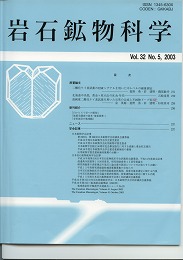All issues

Volume 31 (2002)
- Issue 6 Pages 307-
- Issue 5 Pages 249-
- Issue 4 Pages 197-
- Issue 3 Pages 137-
- Issue 2 Pages 77-
- Issue 1 Pages 1-
Predecessor
Volume 31, Issue 3
May
Displaying 1-3 of 3 articles from this issue
- |<
- <
- 1
- >
- >|
Original Articles
-
Shinji KOBAYASHI, Yoshihiro SAWADA, Takeyoshi YOSHIDA2002 Volume 31 Issue 3 Pages 137-161
Published: 2002
Released on J-STAGE: May 08, 2008
JOURNAL FREE ACCESSA huge volume of lavas and pyroclastic rocks were erupted in Oki-Dogo island in the latest Miocene. They compose the Oki Alkaline Volcanic Group, the Hei Trachyte Group, the Tsuzurao Volcanic Group and the Tokage Trachyte Group. We examine the geology, petrography and geochemistry mainly for the Oki Alkaline Group, and present a magma plumbing story in the latest Miocene age.
The rocks from the Oki Alkaline Volcanic Group are shoshonite, trachyandesite, trachyte and rhyolite, based on their chemical composition and stratigraphy. The trachytes are divided into Trachyte-1 (Nb 35-50 ppm) and -2 (Nb 49-75 ppm), and the rhyolites are divided into Lower Rhyolites (Moderate-SiO2: 71.4-73.6 wt%), Middle Rhyolites (High-SiO2: 74.7-75.7 wt%), and Upper Rhyolites (Low-SiO2: 70.7-71.6 wt%). Lower Rhyolites, Trachyte-1 were formed at the early volcanic stage. Middle Rhyolites, Trachyte-1 were formed at the middle stage, and Upper Rhyolites, Trachytes-1 and -2, trachyandesite and shoshonite were formed at the later stage. Rhyolitic lava domes with different compositions and feeder dikes of trachyte corresponding to individual volcanic vents occur at a number of places. This may indicate that the eruptions took place from several different vents aligned along a circular fracture.
Lower Rhyolites were derived from the lower crust, and Middle Rhyolites were derived from middle crust by partial melting processes. While, Upper Rhyolites, Trachyte-2 and trachyandesite were generated by fractional crystallization from shoshonite magma. The heat source triggered melting of the crusts is inferred to be latent heat of crystallization in the mafic magma. These rhyolite to shoshonite magmas could have ascended through the ring fractures formed by the doming event, and have consolidated as the rocks composing the Oki Alkaline Volcanic Group. After the formation of this group, Cauldron collapse, and it is followed by the eruption of the Hei Trachyte Group and the Tsuzurao Volcanic Group. In the early Pliocene, The tectonic environment of the crust changed from a compressive to an extensional stress field. Then the eruption of the Omine Group and the Tokage Trachyte Group took place.View full abstractDownload PDF (3188K) -
Akiko GOTO, Taichiro HORIE, Tsukasa OHBA, Hirokazu FUJIMAKI2002 Volume 31 Issue 3 Pages 162-173
Published: 2002
Released on J-STAGE: May 08, 2008
JOURNAL FREE ACCESSCarbonate rocks frequently contain some silicate minerals and various xenoliths. Calcareous mudstone is also widely distributed. There is no report of practical analytical method of mixtures of silicate and carbonate by XRF spectrometer. Therefore, we must invent the precise analytical method ranging from silicate to carbonaceous rocks.
In this study, we used low dilution glass beads (sample : flux ratio of 1 : 2) and tried to analyze wide compositional range for such major elements as SiO2, TiO2, Al2O3, MnO, MgO, CaO, Na2O, K2O and P2O5 with trace elements (V, Cr, Ni, Rb, Sr, Ba, Y, Zr, Nb) by XRF spectrometer. In order to analyze ranging from wide compositional samples, we made some standards; such as mixed standards, additive standards and synthetic standards. The mixed standards consist of the mixture of two GSJ standards. The next ones are weighed-reagents added GSJ standards. The beads of weighed-reagents added SiO2 powder are synthetic standards. In addition to them, we used some GSJ standard samples. The glass beads of high CaO content samples are not transparent. We therefore developed the method to make clear grass beads by adding a small amount of SiO2 powder to the samples. As a result, we could perform precise XRF analyses for wide compositional ranges from silicate to carbonate rocks.View full abstractDownload PDF (984K) -
Akira TANAKA, Yasuhiro SHIBUE2002 Volume 31 Issue 3 Pages 174-186
Published: 2002
Released on J-STAGE: May 08, 2008
JOURNAL FREE ACCESSConcentrations of contaminated heavy metals (Cu, Pb, Zn, Cd, Cr, Mn, Ni, Co) in the stream sediments at 21 points of the Akashi River system (Akashi River and Ikawa River) are determined for the assessment of the environmental pollution. These stream sediments were sieved into the three fractions: <63 μm, 63∼125 μm, and 125∼250 μm sized grains. Then the analyses of the heavy metal concentrations were performed after the standard procedure for the environmental analyses. The finest portions of all the analyzed sites show the higher concentrations of the heavy metals than the other two divisions. The loss on ignition (LOI) at 600°C is positively correlated with the metal concentrations. Among the analyzed elements, the correlation for Cd is stronger than the correlations for the other elements. Correlation coefficients for all the analyzed elements are higher than those between LOI values at 1200°C and heavy metal concentrations.View full abstractDownload PDF (734K)
- |<
- <
- 1
- >
- >|